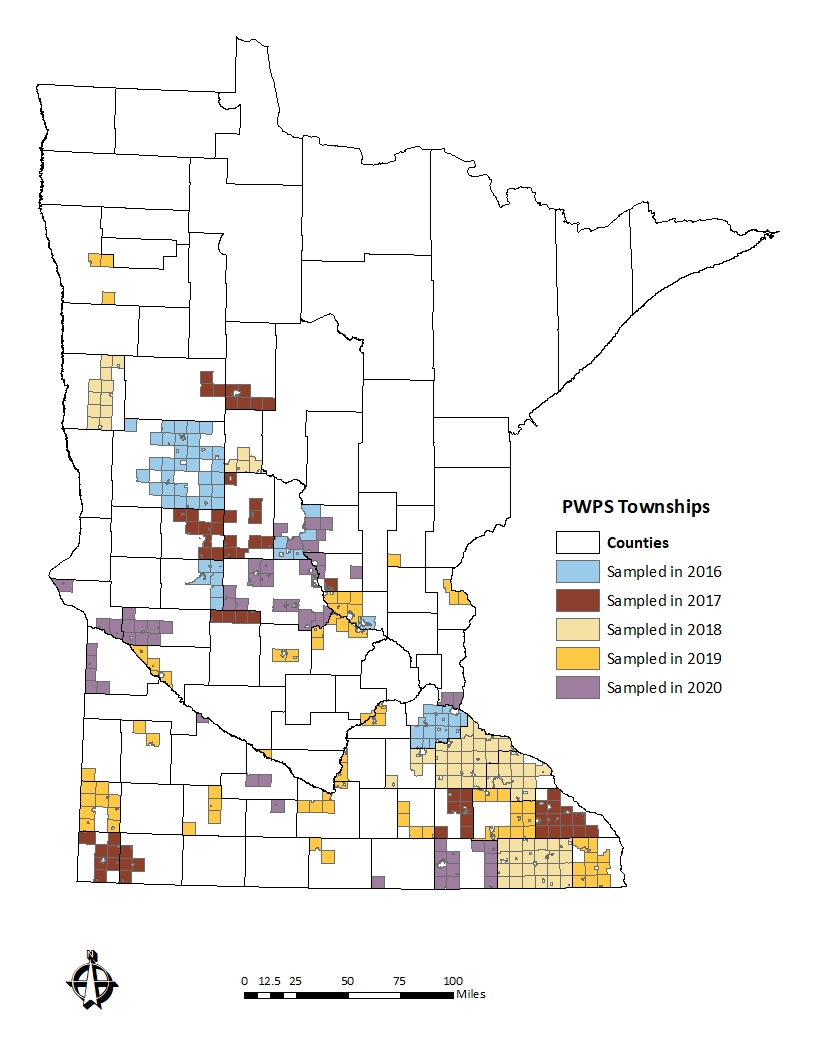
The primary purpose of the Private Well Pesticide Sampling (PWPS) Project is to provide information to homeowners on the presence of pesticides in their drinking water.
The MDA also uses the information collected to help guide pesticide management decision making. Additionally, the information is used to evaluate the relationship between pesticide and nitrate in areas potentially vulnerable to groundwater contamination from agricultural activities.
Phase 1
During Phase 1 of the PWPS Project (2016-spring 2021) wells were selected using the following criteria:
- At least 30% of the township's groundwater is in a geologically sensitive area, vulnerable to contamination
- At least 20% of the township area is in row crop production
- Nitrate was found in the water sampled through the Township Testing Program
During phase 1, tests detect both commonly used pesticides and their primary breakdown products. Once completed, all testing results were shared with homeowners and the general public.
Phase 2
The primary purpose of the PWPS Project Phase 2 monitoring effort is to provide information to well owners regarding the presence of total cyanazine (cyanazine + degradates) in their drinking water. The degradates of cyanazine were identified as the pesticide-related compounds that posed the greatest risk to drinking water, based on sampling performed in the first phase of PWPS. Beginning in the summer of 2021, Phase 2 of the PWPS Project focused on revisiting areas previously tested between 2016-2018, to test for cyanazine degradates that weren't included in the sample list prior to 2019. Pesticide analysis through the contract laboratory includes the parent compounds of cyanazine and atrazine, as well as some of their known degradates, including: cyanazine acid, cyanazine amide, deethylcyanazine, deethylcyanazine acid, deethylcyanazine amide, deisopropylatrazine, and didealkylatrazine. Desethylatrazine and hydroxyatrazine, which are degradates of atrazine, are also included.
2024 MDA efforts are focused on:
- Hotspot Sampling - To better define local extent and magnitude in areas with known clusters of wells exceeding the total cyanazine HRL of 1,000 ng/L, as well as nearby areas with vulnerable geology and historic agricultural land use, the MDA will target untested wells in Washington, Dakota, Goodhue, and Scott counties.
- Long-Term Sampling - The MDA will target wells that previously indicated a total cyanazine concentration over 1,000 ng/L, on a three-year reoccurring basis, to assess how concentrations are changing over time.

The Groundwater Protection Act (MN Statute 103H) directs the MDA to evaluate the detection of pollution resulting from agricultural chemicals in groundwater (MN Statute 103H.251). At the direction of the Minnesota Legislature (Minnesota Session Law 2013, Chapter 137, Article 2, Section 3, part b) the MDA began evaluating pesticide presence and magnitude in private residential drinking water wells in Dakota County in September of 2014 as part of the PWPS Pilot Project. The PWPS Pilot Project served as a model for the implementation of the PWPS Project throughout the state.
Counties and townships are selected using the techniques defined in the PWPS Project Work Plan. The cost of sampling and testing is free to the homeowner.
Homeowner Responsibilities to Participate
- If you have been selected for testing, complete the PWPS Project consent form.
- Allow MDA hydrologists on your property to collect pesticide and nitrate samples from your outside water faucets.
- Participate in a homeowner survey about the well information and potential nitrate sources.
MDA Responsibilities
- Provide supplemental funding for the program.
- Assist with local coordination.
- Collect samples according to protocol and submit to contracted laboratory for analysis.
- Manage and organize results.
- Conduct statistical analysis and data summary

